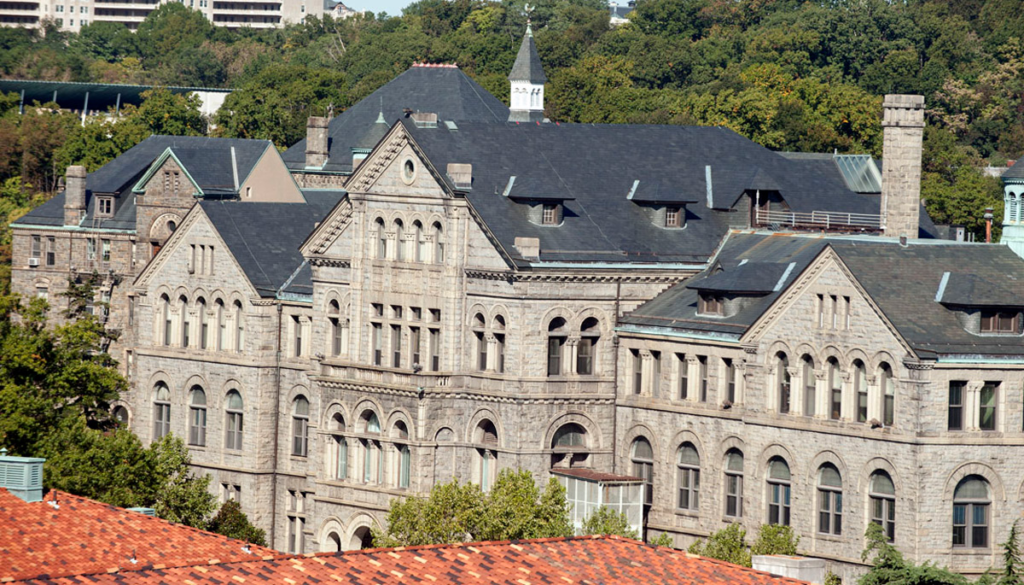CUA Underpays Faculty, New Study Reveals

Courtesy of Catholic University
By Cristina Goerdt
The Catholic University of America currently compensates its faculty and staff at a rate of 8% below the market median compared to similar universities, a new study has found. The study, conducted by consulting firm Mercer, was commissioned by university leadership in April 2019 and presented to the Academic Senate in January 2020, according to Provost Aaron Dominguez.
Dominguez explained that the need for the study was evident after a 2019 climate survey in which faculty and staff stated increased pay as a priority.
Following the study, the university plans to fundraise and reallocate funds to properly adjust salaries over the next two to three years, according to Dominguez.
To adjust where the median salary falls, Senior Associate Vice President for Administration Matthew McNally said that the human resources department will begin reaching out to the heads of departments over the next two to three years to address individual needs across the entire university.
President John Garvey declined to comment for this article, communicating through a spokeswoman that he would prefer to direct all questions to Dominguez.
Associate professor of engineering and chair of the Faculty Assembly (FA) Bihn Q. Tran said that the faculty initiative for fair compensation has “been going on for a long time.”
According to Tran, who has been a CUA employee for over twenty years, CUA enacted a pay freeze 10 years ago during the height of the Great Recession. However, in the years since the economic recovery, no adjustments have been made to make up for the increased cost of living in the D.C. area, nor have salaries risen in accordance with faculty and staff performance.
In order to further their case, the Faculty Senate conducted a study in 2019 to compare CUA salaries to those of other professors at local universities, Tran said. The study determined that CUA faculty and staff make on average 15-20% less than their D.C.-based peers such as George Mason University, Gallaudet University, and Georgetown University, he said.
The Mercer study was structured to compare CUA median salaries by school to those of “comparable institutions,” said McNally.
According to the data provided in the report, universities were chosen based on several factors: public or private institution, the coastal and geographic location, total enrollment, religious or nonreligious affiliations, urban or suburban location, Carnegie research classification, revenue, and tuition as a percentage of core revenue.
In total, 41 universities were included in the study, all of which were classified as urban. All local D.C.-Maryland-Virginia area universities were included in the study, regardless of religious affiliation or public school status.
McNally said that while the Mercer study provides a benchmark for CUA’s next steps, the study is far from perfect. The study, he said, does not include faculty and staff reporting salary, which is “ambiguous.”
Furthermore, McNally elaborated, the market median measurement used in the study fails to take into account factors such as salary distribution, length of employment, and an employee’s prestige in their field. In order to collect staff salary data, industry benchmarks were used, McNally said.
McNally stressed that the study’s findings do not guarantee an automatic raise for every member of faculty and staff.
It is unclear if the lack of pay raises has hindered CUA’s ability to recruit and retain faculty. According to McNally, other incentives, such as benefits, schedule flexibility, and paid time off were also not included in the study.
“That may be why they’ve stayed here at less base pay,” McNally said.
Tran said that the faculty assembly found the study insufficient. He argued that many of the schools included in the study are not comparable to CUA.
For example, CUA’s revenue nears $200 million, dwarving schools such as Notre Dame of Maryland University, which reports a mere $40 million in revenue.
“When you’re doing that, you’re padding the numbers so you can bring down the averages,” said Tran.
According to a statement from the FA, 17% of institutions in the study have revenues under $100 million. Furthermore, nearly 42% of schools used in the study are not Carnegie class research universities.
Additional disparities in the data are seen in the range of enrollment: 13 institutions deemed “comparable” had total enrollments at least twice the size of CUA’s.
Many faculty members are concerned that the study was constructed to purposefully minimize the wage gap. “There’s skepticism about whether or not this data is real,” said Tran.
Faculty and staff in the Conway School of Nursing are particularly disgruntled about the 1% wage gap estimated by the Mercer study. According to Tran, many feel that the projection insufficiently reflects the current market salary for nurses.
In order to make the study more precise, Tran suggested isolating several variables that make Catholic University unique, such as the School of Canon Law, and conducting a separate study to investigate the needs of those specific schools.
Further analysis should also consider tenure versus non-tenure track professors, performance, and the number of years a professor has taught at CUA.
Additionally, the FA recommended that the cost of living be accounted for the salary adjustment analysis. According to figures provided by the FA, the cost of living in the D.C. area rises at a rate of 2% per year.
Lastly, the FA noted that the study failed to take into account pay disparities that may be caused by gender.
“The fact that the Conway School of Nursing is 95% female and has the lowest salary of all schools/departments, raises the question of potential gender salary inequity,” the FA report states.
Dominguez echoed this sentiment, stating that the university is “committed” to prioritizing the budget in order to fairly compensate employees.
Tran believes that some of the administration’s reluctance to address the wage gap stems from the lack of rising enrollment. Revenue is often focused on other areas of the university, Tran said, so when it comes to raising wages, “the resources just aren’t there.”
McNally echoed a similar belief, stating that compensation was “underfunded for quite some time” in order to invest in university infrastructure and other needs.
In an article dated Feb. 6, Garvey defended the traditional Catholic position, upheld by the courts, that the National Labor Relations Board (N.L.R.B.) has no right to interfere with religious institutions.
“The government should be especially careful about meddling in relations between religious schools and their teachers,” Garvey wrote.
Jude R. Nitsche, a CUA alumnus who also serves on the Advisory Board for the School of Engineering, raised concerns that Garvey’s stance provided a justification for failing to raise faculty and staff salaries.
“If CUA is in fact ignoring the low pay of its teachers, it would certainly not be in keeping with Catholic social teaching regarding the dignity of work and the rights of workers,” Nitsche wrote.
Dominguez stated that he felt disappointed by the results of the study, especially because faculty and staff have been attempting to enact change on this issue for several years.
“But we feel blessed and fortunate that we can work on this issue now. I think it’s a very positive thing,” Dominguez added. “It’s a matter of respect to pay someone a just wage.”






